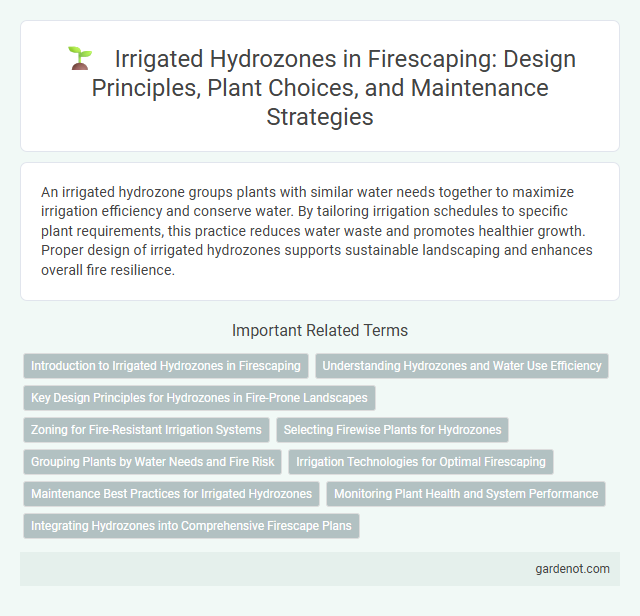An irrigated hydrozone groups plants with similar water needs together to maximize irrigation efficiency and conserve water. By tailoring irrigation schedules to specific plant requirements, this practice reduces water waste and promotes healthier growth. Proper design of irrigated hydrozones supports sustainable landscaping and enhances overall fire resilience.
Introduction to Irrigated Hydrozones in Firescaping
Irrigated hydrozones in firescaping refer to designated landscape areas that receive controlled irrigation to maintain moisture levels and reduce wildfire risk. These zones typically contain fire-resistant, drought-tolerant plants strategically selected to minimize fuel for fires while optimizing water use efficiency. Properly designed irrigated hydrozones enhance defensible space around structures by promoting vegetation health and reducing the potential for fire spread.
Understanding Hydrozones and Water Use Efficiency
Irrigated hydrozones group plants with similar water needs, optimizing irrigation schedules to enhance water use efficiency and minimize waste. Utilizing soil moisture sensors and drip irrigation tailored to each hydrozone reduces overwatering and promotes healthier plant growth. Properly designed hydrozones contribute to sustainable firescaping by maintaining vegetation that balances fire resistance with efficient water consumption.
Key Design Principles for Hydrozones in Fire-Prone Landscapes
Irrigated hydrozones in fire-prone landscapes should be strategically designed to minimize fuel accumulation while maintaining plant health through efficient water use. Key design principles include grouping plants with similar water needs to reduce irrigation waste, using fire-resistant species with low resin and oil content, and incorporating hardscape features or mulch to create defensible space and reduce ignition potential. Proper spacing and zoning help limit fire spread by creating natural firebreaks within the landscape.
Zoning for Fire-Resistant Irrigation Systems
Irrigated hydrozones designed with fire-resistant principles utilize zoning to separate plant types based on their water needs and flammability, reducing fire spread potential. These zones often include low-volume drip irrigation systems for high-risk areas, minimizing water waste while maintaining soil moisture critical for fire resistance. Proper zoning enhances vegetation health and creates defensible spaces by strategically placing irrigation where it's most effective in preventing wildfire damage.
Selecting Firewise Plants for Hydrozones
Selecting Firewise plants for irrigated hydrozones involves choosing vegetation with low flammability and high moisture content, such as succulents, ornamental grasses, and deciduous shrubs. These plants create natural firebreaks by maintaining higher fuel moisture and reducing surface fire intensity. Incorporating native, drought-tolerant species adapted to local climate further enhances fire resilience and irrigation efficiency.
Grouping Plants by Water Needs and Fire Risk
Irrigated hydrozones improve firescaping by grouping plants with similar water requirements and fire resistance, reducing irrigation waste and fire hazards. Selecting drought-tolerant, low-flammability species like succulents and native grasses within these zones minimizes fuel availability and enhances landscape resilience. Proper zoning supports efficient water use and creates defensible spaces that slow wildfire spread and protect properties.
Irrigation Technologies for Optimal Firescaping
Irrigated hydrozones utilize advanced irrigation technologies such as drip emitters and smart controllers to precisely deliver water tailored to fire-resistant plant species, enhancing fire safety while conserving resources. Soil moisture sensors integrated with automated irrigation systems enable real-time adjustments, reducing overwatering and minimizing flammable vegetation growth. These technologies promote efficient water use in firescaping designs, supporting resilient landscapes that comply with defensible space requirements.
Maintenance Best Practices for Irrigated Hydrozones
Proper maintenance of irrigated hydrozones includes regular inspection and adjustment of irrigation systems to prevent water waste and ensure optimal plant health. Scheduling irrigation based on soil moisture levels and seasonal weather patterns enhances water efficiency while reducing fire risk. Removing dead plant material and managing vegetation density within hydrozones further minimizes fuel loads and promotes fire safety.
Monitoring Plant Health and System Performance
Regular monitoring of irrigated hydrozones involves assessing soil moisture levels and plant health indicators such as leaf color, wilting, and growth patterns to optimize water use in fire-resistant landscapes. Utilizing smart irrigation controllers and soil moisture sensors enhances system performance by adjusting watering schedules based on real-time environmental conditions. Tracking these metrics helps prevent overwatering and under-watering, promoting vigorous plant growth that serves as a natural firebreak.
Integrating Hydrozones into Comprehensive Firescape Plans
Integrating irrigated hydrozones into comprehensive firescape plans enhances landscape resilience by promoting fuel moisture continuity and reducing wildfire risks. Strategic placement of drought-tolerant, fire-resistant plants within hydrozones allows for efficient water use while maintaining defensible space around structures. Employing drip irrigation and moisture sensors ensures optimal hydration, supporting plant health and contributing to a sustainable firescape that balances fire safety and water conservation.
Irrigated hydrozone Infographic

 gardenot.com
gardenot.com